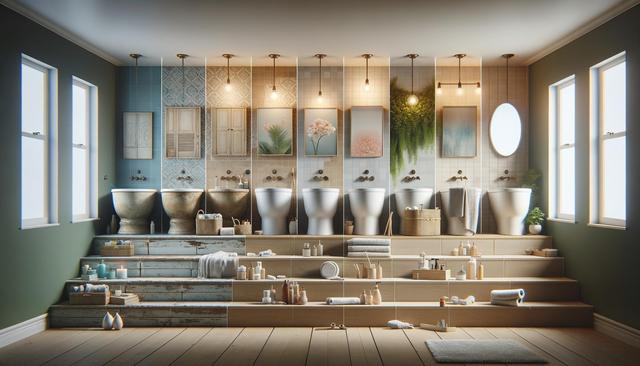Popular Bathroom Design Styles to Consider
When planning a bathroom remodel, selecting a design style is an essential first step. The style you choose will influence everything from tile selection to fixtures and finishes. A few popular design styles have gained significant traction due to their timeless appeal and adaptability to different spaces.
Among the most favored styles are:
- Modern: Characterized by clean lines, minimalistic fixtures, and a neutral palette, modern bathrooms emphasize function and simplicity.
- Traditional: This style often includes ornate mirrors, classic vanities, and rich color schemes that evoke a sense of warmth and familiarity.
- Farmhouse: Rustic wood accents, vintage fixtures, and shiplap walls bring a cozy, down-to-earth vibe that’s both inviting and stylish.
- Industrial: Inspired by urban lofts, industrial bathrooms may feature exposed pipes, concrete elements, and metal finishes.
- Transitional: A blend of traditional and contemporary, this style offers versatility and balance with a mix of modern and classic elements.
Choosing a style that aligns with your taste and the overall feel of your home can create a cohesive design that’s both functional and visually appealing.
7 Essential Steps for a Successful Bathroom Remodel
Remodeling a bathroom involves more than just replacing old tiles or installing a new vanity. A well-organized approach can help avoid unnecessary delays and costs. Here are seven steps to guide your remodel from start to finish:
- 1. Set a budget: Determine how much you are willing to spend and allocate funds to each aspect of the project.
- 2. Plan your layout: Decide if you’re keeping the existing layout or making structural changes to enhance functionality.
- 3. Choose your design style: As discussed earlier, your style will guide many of your material and fixture choices.
- 4. Select materials and fixtures: Research options for flooring, tiles, vanities, lighting, and plumbing fixtures that fit your style and budget.
- 5. Hire professionals: Depending on the complexity of the job, you may need contractors, electricians, and plumbers.
- 6. Obtain permits: Check local building codes to see if permits are required, especially for plumbing or electrical work.
- 7. Execute and monitor progress: Once the work begins, regularly check in on progress to ensure timelines and quality standards are being met.
Following these steps can help you avoid costly mistakes and ensure a smoother remodeling process.
What Tends to Be the Most Expensive Part of a Bathroom Remodel?
Bathroom remodels can vary widely in cost depending on the size of the space and the scope of the project, but certain elements tend to consume a larger portion of the budget. Understanding which areas are typically most expensive can help you plan more effectively.
The most costly parts often include:
- Labor: Skilled trades like plumbing and electrical work are essential and often account for a significant portion of the total cost.
- Plumbing fixtures: Relocating plumbing lines or upgrading to high-end fixtures can quickly increase expenses.
- Tile work: Custom tiling, especially in showers and floors, is labor-intensive and material costs can add up.
- Cabinetry and vanities: Especially when custom-built or made from premium materials.
To manage costs, consider whether each upgrade is necessary or if a more cost-effective alternative can deliver similar results. For instance, keeping plumbing lines in place and opting for prefabricated vanities can yield significant savings.
Affordable Ways to Refresh Your Bathroom
Remodeling a bathroom doesn’t always require a full-scale renovation. There are many budget-friendly ways to update your bathroom and give it a fresh, modern look. Small changes can make a big impact when applied thoughtfully.
Here are some cost-effective upgrades to consider:
- Paint and wallpaper: A new coat of paint or peel-and-stick wallpaper can dramatically change the room’s atmosphere.
- Update hardware: Replacing drawer pulls, cabinet knobs, and faucet handles can modernize the look with minimal investment.
- Refinish instead of replace: Reglazing a bathtub or repainting a vanity can breathe new life into old fixtures.
- Install new lighting: Swapping out an old light fixture for a more stylish one can enhance both aesthetics and functionality.
- Add shelving or storage: Floating shelves or over-the-toilet storage units can increase organization in a simple and attractive way.
These changes not only improve the aesthetic appeal but also increase usability without requiring a large budget or extensive labor.
Planning for Longevity and Style
Before starting your remodel, it’s important to think long-term. A bathroom should be both stylish and practical for years to come. Choosing materials and finishes that are durable and low-maintenance will reduce the need for frequent updates.
Focus on:
- Moisture resistance: Materials like porcelain tile or quartz countertops are strong choices for wet environments.
- Neutral tones: These provide flexibility for future design updates without requiring full makeovers.
- Energy-efficient fixtures: Low-flow toilets and LED lighting can reduce utility costs over time.
- Universal design: Features like walk-in showers, grab bars, and wider doorways can make the bathroom more accessible for all ages.
By combining functionality with thoughtful design, you can create a bathroom space that adapts to your needs and continues to add value to your home over time.


